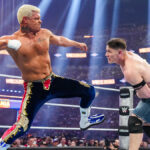In the realm of wrestling, few embody WWE’s essence like Triple H. Debuting as the Connecticut Snob in 1995, he has carved out a legendary career with numerous titles and main events, including countless WrestleMania appearances. Beyond the ring, he’s played a pivotal role in shaping WWE’s direction, especially as a creative force behind “WWE NXT,” contributing to a significant resurgence in the company’s creativity over recent years.
One defining aspect of Triple H’s legacy is his impressive physique. To many, he represents the quintessential image of a professional wrestler: tall and muscular. Today, as WWE’s Chief Content Officer, Triple H has experienced a remarkable transformation in his appearance, and we’ll be exploring his evolution from an aspiring powerlifter to one of wrestling’s most influential figures.
Teenage Bodybuilding Beginnings
Born on July 27, 1969, in Nashua, New Hampshire, young Paul Levesque was inspired by professional wrestling, particularly after watching Chief Jay Strongbow. While many were drawn to the action, Levesque was captivated by the wrestlers’ physiques.
At just 14, he ventured into bodybuilding, aimed to sculpt his body like the grapplers he admired. By 1988, he claimed the title of Mr. New Hampshire, showcasing extraordinary dedication to his workouts and diet despite being thin initially. Along the way, he was introduced to legendary powerlifter Ted Alcidi, which further fueled his passion for fitness.
WCW Stint
Training at Killer Kowalski’s wrestling school in Massachusetts, Levesque eventually adopted the ring name “Terrarising.” Debuting in 1990, he quickly bulked up to approximately 230 pounds, catching the attention of World Championship Wrestling (WCW), which signed him in 1994.
Although he debuted under the uninspired name “Terrarising,” WCW was the first major promotion to recognize his potential. However, the gimmick didn’t resonate as hoped, leading to a change that would become instrumental in his later success.
Hunter Hearst Helmsley
By late 1995, Levesque switched to WWE, where he was renamed Hunter Hearst Helmsley. This new persona—portraying an upper-class American rather than a Frenchman—set the stage for his rapid rise in WWE.
As he adopted a more polished look, he became known for his athletic build and signature long tights, although fans eventually grew weary of gimmick-heavy characters, paving the way for a new era in WWE.
The Attitude Era
After winning the 1997 King of the Ring, Hunter’s character underwent a transformation as he co-founded Degeneration X with Shawn Michaels and Chyna. This marked a shift in his style, trading upscale wardrobes for leather jackets and casual wear.
During the late 1990s, Triple H’s evolution into a key player in WWE led him to a dominant position as he embraced a more aggressive in-ring style. By 2001, he had become one of the top stars of wrestling during the Attitude Era.
Return in 2002
In January 2002, Triple H made a notable return after recovering from a severe injury that had sidelined him. His comeback was monumental, especially when he appeared at Madison Square Garden, showcasing a significantly bulked-up physique.
This era marked the peak of his physical transformation, where his size and strength became a defining characteristic of his wrestling persona.
Ruthless Aggression Era
During the Ruthless Aggression Era (2002-2005), Triple H emerged as a central figure, leading a faction known as Evolution alongside Ric Flair, Randy Orton, and Batista. This group dominated the wrestling landscape, holding all male titles by the end of 2003, signifying Triple H’s status at the top.
As his appearance evolved, he returned to a clean-shaven look and adopted new ring gear, emphasizing his commitment to adapt as the audience’s preferences shifted.
Physical Decline
After suffering a torn quadriceps in 2007, Triple H faced numerous injuries, prompting changes in his wrestling style and appearance. His physique became leaner as he adjusted to the rigors of wrestling in a more physically demanding environment.
This transition arrived as WWE moved into a new era focusing on a more family-friendly atmosphere, leading to Triple H taking on a part-time role.
Life-Changing Health Scare
Following his inability to defeat The Undertaker at WrestleMania, Triple H transitioned to a part-time in-ring career while cultivating the NXT brand. However, a near-fatal heart incident due to viral pneumonia prompted him to reassess his career.
This health crisis resulted in him stepping away from active wrestling, but he continued to shape the future of WWE behind the scenes, marking a significant change in his career trajectory.
Paul Levesque: Chief Content Officer
As of 2022, Triple H officially retired from in-ring competition and took on the role of WWE’s Chief Content Officer. Now known more as Paul Levesque, he has transitioned from a wrestling superstar to a key figure in creative leadership within WWE.
Despite significant changes to his appearance and health, Levesque remains active in shaping WWE’s future, marking a profound evolution from his early bodybuilding days to his rise as a corporate leader in professional wrestling.
Fan Take: Triple H’s journey from a bodybuilding teen to WWE’s creative powerhouse signifies the immense impact individuals can have on professional wrestling. This evolution not only illustrates the importance of adaptability in the industry but also inspires fans about career growth and transformation within the sport.











